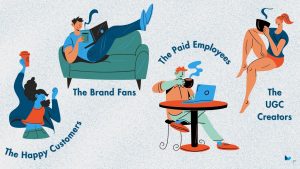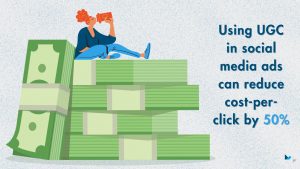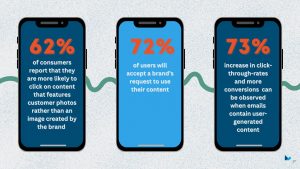The Value of User-Generated Content
In the ever-evolving marketing landscape, user-generated content (UGC) has emerged as a powerful tool that every marketer should have in their back pocket. Gone are the days when traditional marketing tactics held the sole spotlight and in is the new dawn of user-generated content creating genuine connections between consumers and companies. Savvy marketers around the world understand the value of empowering their customers to become brand advocates and storytellers. User-generated content, authentically created and shared by individuals, has become a driving force shaping consumer perceptions, fostering trust, and propelling businesses forward. Come along as we delve into the remarkable effectiveness and undeniable value of UGC in the modern marketing world, exploring what user-generated content really is, why it’s important, how it works, and the key to harnessing its awesome power for your brand.
What is UGC and Who Does it Come From?
You’re probably wondering, what is user-generated content anyway? User-generated content (UGC) refers to any form of content that is created and shared by individuals, rather than by brands or professional content creators. It encompasses a wide range of media, including text, images, videos, reviews, and of course, social media posts. Any time you’ve raved about a restaurant online, posted how comfy and versatile your new pair of sneakers are, or linked to a must-have item for all your friends to shop- you’ve created UGC.
There are different types of consumers who will create and share user-generated content, and different motives for why they would do so. We like to think about these four sects of people as the following: the happy customers, the brand fans, the paid employees, and UGC creators.

The Happy Customers
This is arguably the most organic and purest form of user-generated content you can get. These consumers are posting about your product or brand simply because they love it and they want everyone to know. This is the most valuable form of UGC you can receive because the customers’ reviews are genuine and their followers, as well as yours, can tell. Content from happy customers is the most common type you’ll see posted online- but you can crowdsource this type of content as well. By asking customers to submit testimonies, photos, and videos of them enjoying your product you offer consumers the opportunity to share their love of your brand with the possibility of being featured online. A common way to sort UGC is by hashtags. Create a custom hashtag for this purpose as many brands have done before, like #MyCalvins, #ShareACoke, and #ShotoniPhone to name a few, and watch the free media flood in.
The Brand Fans
These are the brand loyalists, the consumers who love your company unconditionally and will update their audience on anything and everything you do. The fanboys of UGC, you can expect these users to be posting thorough reviews, pros and cons lists, and generally educating the public about the brand you’ve worked so hard to perfect. Think of Apple fans. These tech lovers will share their opinions on current Apple products, their live reactions to new product launches, and film unboxing videos once the coveted new gadgets arrive. No matter what the brand releases, they’re going to have an opinion and want to share it. These are the type of consumers who would be grateful to be on your PR list- but would probably post about your brand regardless!
The Paid Employees
Let’s not forget your employees can create user-generated content too! Content directly from employees can humanize and legitimize your business when done in the right way. People like to feel like they’re supporting people, not a corporation, so allow your workers to share their experience working for your brand. A great way to do this is by sharing behind-the-scenes content about what life is like at the company. Some simple content briefs would be “Pack this order with me”, “Come along on our team lunch”, or “My favorite thing about working here”. It’s amazing if your employees will organically share this type of content on their own social media, but an even better way to reach your customers is by allowing employees to do a social media takeover! Give a trusted worker the login to your business’s Instagram and let them walk your followers through a day in the life via Instagram stories. The engagement and interest will be through the roof.
UGC Creators
Treading the fragile line between user-generated content and influencers lies UGC creators. What makes these creators different from influencers is that you aren’t paying them to create content and promote it to their audience, you’re commissioning them to create content that you will own and be free to post on your communication channels. These creators may have a sizable following or barely any clout to their name- it doesn’t matter! All that matters is that they’re willing to create content from the point of view of a user and give you the rights to publish it as you please. Content from UGC creators can be easily used in ads, on your social media, and even on your website. This content can be posted on the creator’s personal accounts as well, but the benefit you receive from owning the content is the main play here. UGC creators can be found by simply reaching out on social media, or through sites that source these types of creators for you like Home From College and TINT.
Permission
As a hard rule, you must ask permission to use anyone’s content online. An email, or even better a simple DM, are quick ways to gain permission from social media users to promote their content on your site or social media. It’s better to be safe than sorry- and a quick confirmation or denial is always better than a lawsuit. Although getting permission could seem like a roadblock, studies show sharing users’ content has returning benefits for your brand. According to Tint’s The State of Social & User-Generated Content 2023 Report, 64% of consumers agree that when a brand they like and use re-shares content by customers, they are more likely to share content about the brand or its products. That’s right, free advertising from loyal customers is out there! And they’re more likely to share your brand’s content if you’re willing to share theirs.
Why is UGC Important?
In our current over-saturated market where consumers are bombarded with an endless stream of advertisements, user-generated content offers a breath of fresh air. After all, people trust people, not marketers.

Growth
While UGC has been around for a while it’s only gained the recognition it deserves as a tool for building communities and driving conversions in recent years. And this growth in popularity isn’t slowing any time soon. According to BusinessWire’s User Generated Content Platform Market Analysis Report 2021, “The global user-generated content platform market size is expected to reach USD 18.65 billion by 2028. The market is expected to expand at a compound annual growth rate (CAGR) of 26.6% from 2021 to 2028.” That’s a whole lot of cheddar up for grabs, and we understand why. Younger generations care more about the opinions of others on the internet than the generations before them, and this search to limit cognitive dissonance will lead to conversions.
Looking again at BusinessWire we find that “When evaluating purchase decisions, 70% of Gen X and Gen Z respondents and 78% of Millennials reported finding it “very” or “extremely” helpful to know how other product users feel about purchases, whereas only 52% of Baby Boomers and 45% of the Silent Generation reported the same.” This means that UGC is going to make more and more of a difference in purchase decisions as time goes on. Investing in this type of content is wise, and the best part is, sourcing UGC is cheap.
Cost
Using UGC can be a huge money saver. Since the users are creating the content for you, you don’t have to hire a photographer, a model, and an editor to get the final shot. Part of the value is in the authenticity of the media. We’re so programmed to swipe away from anything that looks like an ad, we’re more likely to take a good long look at raw UGC. And the more time we spend staring at an ad, the more utility the brand receives from paying to put the ad up in the first place! To put it in perspective, consider these stats:
- Using user-generated content in social media ads can reduce cost-per-click (CPC) by 50%.
- 93% more dwell time is reported on user-generated content pages than on corporate image galleries.
Is UGC Effective?
If you still aren’t convinced of the awesome power of user-generated content, let us enlighten you further as to why it works and what it can do for your brand.

Community
User-generated content creates a sense of community! By encouraging and featuring UGC, brands open the doors for their customers to actively participate in the brand experience, creating a shared space where individuals can bond over their common interests. When customers see their content being showcased and acknowledged by the brand, it creates a sense of validation and belonging. UGC enables users to become co-creators and brand advocates, forging a deeper emotional connection with the brand and fellow customers.
And this connection pays off. It cultivates a community-driven environment where users can interact with each other, exchange ideas, and share their passion for the brand. Community creates engagement, as 6 in 10 marketers report that their audience engages more with UGC in marketing and communications channels than branded content. Through UGC, brands can tap into the collective creativity of their community, leveraging the power of authentic user stories to strengthen loyalty, build trust, and foster a sense of belonging among their customers.

Social Proof
UGC also offers customers social proof. And you know what they say, the proof is in the pudding, the social proof pudding that is. Forbes discusses social proof as such, “Social proof is the validation prospective buyers need and existing customers provide about a product or service. Put simply, social proof is someone else’s stamp of approval.” Consumers want to limit their cognitive dissonance, meaning they want to feel secure in their purchase and gain this security from the reassurance of others. People often turn to their family, friends, and coworkers for advice, but what happens when none of these people have tried the new Fenty Beauty foundation you have your eye on? That’s where UGC comes in! Platforms like Instagram and especially Tik Tok have made it easier than ever to find exactly what you’re looking for in terms of honest reviews. And as internet natives- we can sniff out a brand deal over organically created content before we even see the dreaded #ad.
When consumers see fellow customers sharing positive experiences, reviews, or testimonials about a product or service, it validates the brand’s claims and instills trust. This social proof acts as a powerful reassurance, mitigating any doubts or uncertainties that potential buyers may have. Whether it’s through customer reviews or social media rants, UGC taps into the collective wisdom of a community, allowing consumers to gain insights and make more informed decisions. By leveraging the social proof inherent in UGC, brands can build credibility, strengthen their reputation, and ultimately drive conversions.
Straight-Up Stats
While these qualitative benefits are undoubtedly powerful, and we’ve peppered in a few stats to pique your interest, we know that nothing hits quite the same as cold hard quantitative evidence. Therefore, let us present you with the following statistics to vividly illustrate the impact of UGC on brand reach, engagement, and consumer behavior. Prepare to be convinced by the undeniable data-backed insights we’re about to unveil from TINT’s The State of Social & User-Generated Content 2023 Report, Digital Information World, and HubSpot.
72% of consumers believe that reviews and testimonials submitted by customers are more credible than the brand talking about their products.
62% of consumers report that they are more likely to click on content like ads, websites, social posts, or emails, that feature customer photos rather than an image created by the brand.
When emails contain user-generated content, click-through rates increase by about 73% and produce more conversions.
When websites featured user-generated content there has been an increase of 29% in web conversions.
Websites with featured user content saw a 20% increase in return visitors. Additionally, these websites recorded a 90% increase in time spent on-site.
76% of consumers have purchased a product because of someone else’s recommendation before.
60% of consumers wish that more brands would tell their fans and customers what type of content they want them to create.
72% of users will accept a brand’s request to use their content, meaning people are excited to participate when brands ask them for rights to repurpose their content.
64% of consumers have tagged a brand or used a hashtag on social media before.

Harnessing UGC for your Brand
Now that you know the ins and outs of user-generated content, I’m sure we can agree that the value of UGC in the modern marketing world cannot be overstated. So, as you embark on your marketing journey, we encourage you to embrace the power of user-generated content and consider incorporating it into your brand’s strategy. By doing so, you will unlock new levels of authenticity, connection, and impact that will resonate with your audience and propel your brand forward into the future. Take the leap, engage your customers, and unleash the immense potential of user-generated content. Your brand and your customers will thank you for it.
Looking to improve your brand’s online presence with the help of a full-service digital agency? Contact us, HMG Creative!
